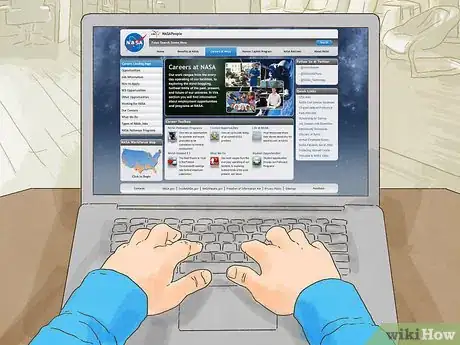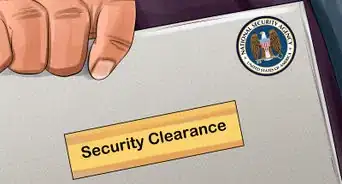wikiHow is a “wiki,” similar to Wikipedia, which means that many of our articles are co-written by multiple authors. To create this article, 27 people, some anonymous, worked to edit and improve it over time.
There are 10 references cited in this article, which can be found at the bottom of the page.
wikiHow marks an article as reader-approved once it receives enough positive feedback. This article received 71 testimonials and 87% of readers who voted found it helpful, earning it our reader-approved status.
This article has been viewed 532,500 times.
Learn more...
The National Aeronautics and Space Administration (NASA) is a governmental US agency, specializing in the nation's aeronautics, aerospace, and space program. NASA's vision statement is: “To reach for new heights and reveal the unknown so that what we do and learn will benefit all humankind”.[1] There are many exciting career opportunities with NASA, and there are many different paths to NASA. A career with NASA can be exciting, creative, and important, but it can also be demanding and competitive. If it's your dream to work with NASA, we've got some helpful advice on how to plan your path to an eventual career with them, in additional to offering you some practical advice about how to handle the application procedure.
Steps
Studying Hard
-
1Learn about the different opportunities with NASA. When you think of NASA, your first thought is probably of astronauts; if going to space doesn't sound so appealing to you, you may nonetheless find a rewarding career with NASA. Just a few of the professionals that NASA employs are as follows:[2] [3]
- Medical doctors, nurses, and mental health care professionals.
- Researchers, engineers, geologists, microbiologists, and physicists.
- Writers, human resource specialists, and communications professionals.
- Computer programmers and IT specialists.
-
2Identify your academic talents. If you'd like to start down the path towards working for NASA, it will help to think about what you're good at as early as possible. This will help you begin to formulate an idea of the position at NASA that would be the best fit for you. Think about the following:
- What subjects do you excel in at school? For example, if everyone wants to be your lab partner in physics class, then you may want to think about a future career in applied physics with NASA.
Advertisement -
3Identify your passions and interests, too. Even if you're really good at something—like math or chemistry, for example—a career at NASA will be intense, as will the course of study you'll have to go through in order to qualify. You want to try to select a path where you will not only excel, but which you'll be passionate about.
-
4Design a course of study. Once you have a plan in mind for your ideal career at NASA, it will be a good idea to carefully outline the courses you'll take, both in high school and/or college. Meet regularly with your academic advisor to make sure you're taking the right courses, and the right number of them.
- Particularly if you want to be an astronaut, an engineer, or a scientist with NASA, you should choose a STEM (science, technology, engineering, and math) centered education path.[4]
- You should also determine as early as possible if your eventual dream job with NASA will require graduate study. This may affect where you go to school or what courses you choose to take as an undergraduate.
-
5Study hard. It's a bit of joke at NASA to respond to inquiries about how to work there by responding, “Study hard,” but it really is true that this is key.[5]
- You're going to have to be committed to your studies, and make sure not just that you get the necessary grades, but that you truly are able to master the material.
-
6Choose the right school. If you're still in high school and are reading this, then you're doing the right thing by planning your path to NASA early on. Take the time to research college and universities that have strong STEM programs, and get into the very best one that you can.
-
7Research the resumes of current NASA employees. One of the best ways to figure out how to get where you want to go is to see how others before you have done it. You can go to the NASA website to read the bios of some of the successful individuals who work there.
- Pay attention to where they went for their undergraduate and graduate educations, see if they mention having completed any internships or fellowships, etc.
-
8Determine whether you can follow a similar path. Are these schools you can get be admitted to? If you're already in college, but are concerned that your academic program isn't strong enough or prestigious enough, it may be possible for you to transfer for your final year or two of college.
-
9Study broadly. While you will most likely be focused on studying STEM subjects, don't forget entirely about the humanities. For example, studying philosophy, history and/or ethics could be beneficial.
- You'll learn how to read and dissect complicated texts, sharpen your problem-solving and critical thinking skills, and think deeply about important moral questions. All of this will be valuable in your future career with NASA.
-
10Become well-rounded. You should also make it a priority to develop yourself fully: this means that not only will you work on expanding your knowledge, but that you'll take care of your body and work to develop your people and leadership skills. It's also important that you find ways to relax and have fun.
- Try to fit time into your schedule for extra-curricular activities which will help you accomplish these goals. For example, you may want to join the science club, math club, debate team, run for student government, play on the volleyball team, play in the school band, etc.
Identifying the Various Paths to NASA
-
1Learn about the NASA Pathways Intern Employment Program (IEP).[6] NASA has a program called the Pathways Program, which offers three different ways to begin working with them. The NASA Pathways Intern Employment Program is for current college students or for people who have been accepted into a qualifying educational program.
- If you are accepted into the program, you'll be able to perform paid work, learn the necessary skills, and gain the relevant experience and connections to hopefully be able to transition into a career with NASA.
-
2Search for available internships with the Pathway Program. You can either go to NASA's website or to USAJOBS to review all current Pathways opportunities, including the IEP positions. You can also sign up to receive notifications for Pathways opportunities through USAJOBS.[7]
-
3Make sure you meet the eligibility requirements. In order to be eligible for an internship with NASA, you must be a US citizen, be at least 16 by the time you would begin the internship, be actively pursuing a degree and be enrolled or accepted into an accredited educational institution.
- You also need to have and keep a GPA of at least 2.9 on a 4.0 scale
-
4Meet any additional requirements. For some positions, you may need to meet NASA's Aeronautics, Scientific, and Technical (AST) qualification standards. These will be outlined in the specific internship posting.
-
5Apply for the Pathways Internship Program. To apply, you will be directed to the USAJOBS online application system. We'll provide you with more information on how to handle your application in the following method.
-
6Consider applying to the NASA Pathways Recent Graduates Program (RGP).[8] Don't fear if you didn't learn about the internship program while you were enrolled in college. If you recently graduated, or will be graduating this year, you may be eligible for the RGP.
- If your application is accepted, you'll be placed into a 1-year career development program (which in some cases may be extended for an extra year), and which upon completion of the program, may turn into a more permanent job with NASA.
-
7Meet the eligibility requirements for the RGP. To be eligible, you must have graduated from a qualifying educational institution within the last two years, unless you are a qualifying Veteran.
- If your ability to apply was delayed due to your military obligations, you may apply within 6 years of graduating or after having received a qualifying educational certificate.
-
8Apply for the RGP. You can go either to NASA website or straight to USAJOBS to search for current open RGP positions and to apply.[9]
-
9Learn about NASA Pathways Presidential Management Fellows Program (PMF).[10] The final NASA Pathways Program is for individuals who have recently completed advanced graduate course work. Individuals who are accepted are immersed in an intensive leadership development program which can place them on the fast-track to important government positions and careers.
-
10Determine if you are eligible for the PMF Program. If you've received your qualifying advanced degree within the last two years (or if you are on course to finish this year), you may be eligible to apply to be a fellow.
-
11Choose the fellowship you'd like to compete for. There are many government organizations which participate in this prestigious and competitive program (over 100), and NASA is one of them.
- You'll need to visit the PMF website (www.pmf.gov) to learn about the requirements and the application procedure.
-
12Learn about the Astronaut Candidate Program. If you're interested in becoming an astronaut and working at the International Space Program, you'll want to apply to become an Astronaut Candidate.
- If accepted, you'll be assigned to the Astronaut Office at Johnson Space Center in Houston, Texas, where you'll spend approximately two years training intensively and being evaluated for your suitability as an astronaut.[11]
-
13Meet the basic eligibility requirements to apply for the Astronaut Candidate Program. For application to even be considered, you must have the appropriate degree:
- You must have a bachelor's degree from an accredited institution in one or more of the following: mathematics, engineering, biological science or physical science.[12]
- Notice that some degrees which may make you eligible for other work with NASA will not qualify you to become an Astronaut Candidate. For example, degrees in Nursing,Technology, and/or Aviation are not considered qualifying.[13]
-
14Gain experience before applying for the Astronaut Candidate Program. You must have at least three years of additional, relevant, professional experience beyond your undergraduate education before you may apply to this program.[14]
- If you have completed graduate study, it will be allowed to count for some or all of the required professional experience. You can learn more by studying the application guidelines on USAJOBS.
-
15Meet the physical eligibility requirements to apply as an Astronaut Candidate. You will need to be able to pass the NASA long-duration flight physical. Among the requirements:[15]
- Your vision must be correctable to 20/20, and if you've had your vision surgically corrected, a minimum of one year must have passed during which time you showed no complications.
- Your blood pressure while sitting down may not be higher than 140/90.
- You may not be shorter than 62 inches tall nor taller than 75 inches.
-
16Apply through USAJOBS. If you are a civilian, you will apply to become an Astronaut Candidate by going to USAJOBS.
- You will also apply through USAJOBS if you are on active duty in the military, but you may need to go through an additional application procedure through your respective military service (for example, if you are in the army, then contact your local army personnel management for more information).[16]
Applying to NASA Through USAJOBS
-
1Apply to NASA. Even if you didn't participate in a Pathways Program, there are many different “roads” you can take to a career with NASA. While the Pathways Program provides excellent opportunities, you can apply to NASA straight away if you've graduated from college or are in the military.[17]
-
2Visit USAJOBS to find open positions with NASA. While it's a good idea to start your job search by visiting NASA's website—you can learn more about the organization, the people they employ, and the projects they are undertaking—you will be led to USAJOBS to find and apply for specific jobs.
- You can use the search function on USAJOBS to filter the results to show positions with NASA.
-
3Use the notification service from USAJOBS. If you're worried about missing job announcements with NASA, you can sign up to receive email notifications from USAJOBS when a position which matches your qualifications and desired criteria becomes available.[18]
- Just be sure to check your email regularly, and make sure that your spam filters are set such that the notifications won't be send to the wrong email folder or blocked altogether.
-
4Apply to advertised jobs only. NASA doesn't consider unsolicited resumes. As explained above, you should search for open positions by visiting USAJOBS, and/or signing up for email notifications of new positions.[19]
-
5Think carefully about applying through mail. Once you've found a position you'd like to apply for, you'll need to prepare your resume. While NASA does accept mailed hard copy resumes (the address will be listed in the vacancy announcement), they strongly prefer that you use the electronic submission process through USAJOBS.[20]
- It's in your best interest to apply as they prefer, and avoid mailing your materials unless you absolutely need to.
-
6Tailor your USAJOBS resume. You're allowed to create and save up to five different resumes on the the USAJOBS site. You'll then be asked to select the one you want to use for a particular job opening.[21] If you're applying for more than one government position, or more than one job at NASA, you may want to create different versions of your resume to highlight different skills.
- For example, one of your resumes may highlight your teaching experience if you are applying to a job that requires you to train or mentor others, whereas another resume may highlight your research experience.
- Study the job posting carefully to select the resume that best highlights the skills and qualifications you'll need for that job.
- Be sure to make note of which version of your resume you used for particular applications; NASA won't maintain the name you gave the resume.[22]
-
7Keep your resume format simple. You should not use bullet-points or other non-alphanumeric characters in your resume. NASA's computer program won't translate these characters correctly, and your final resume will look sloppy.[23]
- You may, however, use a dash instead of a bullet to emphasize points or to list your experience. [24]
-
8Avoid copying and pasting your resume. It's a good idea to first draft and polish your resume in a word processing program instead of creating it from scratch while applying through USAJOBS. However, you are advised not to copy and paste from your word document into the resume builder.
- Programs like Microsoft word include special characters and hidden code that won't translate properly.[25]
- If you compose your resume using a simple text file, you should be able to copy and paste without issue.
-
9Refer to the job ad often when composing your resume. It's a good idea to highlight the key words in the advertisement for the job your applying to when you tailor your resume. Make sure to include those words and phrases as you outline your work experience and present your skills and competencies.[26]
- Make sure as well to use the appropriate technical terms for your industry.
-
10Avoid padding your resume. NASA recommends that you keep your resume focused on the job you want, and that you avoid using excessive adjectives when describing your experience. You should also avoid trying to fill out your experience by listing irrelevant work experience.[27]
-
11Omit work history which is not relevant. You don't need to include your complete work history on the resume you send to NASA. For example, they don't expect you to list the summer you spent detasseling corn or the side job you had as a bartender while in graduate school.
- You should, however, include your current job, even if it's not directly related to the position you're applying for at NASA.
-
12Provide complete information about your work experience. Once you decide what jobs to list on your resume, be sure to have at hand the dates of your employment, your salary, your employers' addresses and your supervisors' names and telephone numbers.[28]
-
13Be prepared with extra information, if you are or were a Federal employee. You'll need to declare any work you've done with the government. Be ready to list the occupational series number of your position, the exact dates of your employment, dates of your promotions, and the highest grade you held.[29]
-
14Include complete information about your educational history. You will also need to provide the complete names of the schools you've attended and their locations. List as well your major, graduation dates, GPA (and the scale which was used to calculate it), and degrees earned.
- Most jobs at NASA require at least a four-year degree, and often an advanced degree. It's important that your degree come from an accredited institution recognized by the Department of Education, and not a “diploma mill”.[30]
-
15List your accomplishments. You should also include a list of any awards you've won, training you've completed, publications you've authored or co-authored, etc. Be sure to include specific titles and dates.
- You should also outline the computer software, tools, and/or equipment you've used or mastered which could be relevant to this new job.
-
16Keep it concise. USAJOBS has no length limit on the resume you create through their system, but NASA does. They won't consider resumes over six typed pages (approximately 20,000 characters).[31]
-
17Skip the cover letter. NASA doesn't accept cover letters as part of the application process, nor does it accept other documents such as SF-171, OF-612, DD-214, SF-50, or SF-15.[32]
-
18Read the job ad to see if supporting documentation is required. NASA typically doesn't request that you send supporting documentation when you first apply for an open position. Read the ad carefully, though, in case there is an exception to this general rule.
- You should also monitor your email carefully for any requests that come your way after your resume has been submitted.
- Some jobs, for example, may require you to send your college transcripts, or you will have to follow up with proper documentation if you're requesting veteran's preference.[33] These requests typically come near the end of the hiring process, though.
-
19Submit your USAJOBS resume. Once you've completed your online resume with USAJOBS, it will be transferred to the NASA Staffing System (NASA STARS). This system will extract the information that NASA is concerned with from your basic USAJOBS resume.
-
20Review your resume as it was extracted from the USAJOBS site. Note that not all of the fields are extracted. For example, NASA doesn't extract info from the “Languages” “Organizations/Affiliations” or “References” sections.[34]
- It doesn't hurt to fill out these sections in your general USAJOBS resume, but don't freak out when you don't see them on your NASA STARS resume.
-
21Answer screening questions. NASA STARS may ask you to answer some additional questions once your resume has been extracted. These verify that you meet the minimum qualifications and that you're interested in the position.[35]
-
22Answer supplemental questions. You may be asked to answer supplemental questions while completing your USAJOBS resume. If so, your answers will be transferred, but you'll need to verify that they were transferred completely. You can use this opportunity to amend or revise your answers.
-
23Answer additional questions for specific jobs. For example, some SES (Senior Executive Service) positions require you to complete the SES Executive Core Qualifications (ECQ) and SES Executive Technical Qualifications questions. NASA recommends that you complete these off-line using a simple text editor and then fill in your answer once you've been able to give them careful thought and attention. [36]
- These questions are designed to assess whether you have the appropriate managerial and leadership skills and experience, as well as the required technical knowledge and skills.
-
24Be on the alert for a notice of receipt. Once your supplemental questions have been answered, you'll receive an email notice from NASA which verifies that your application has been received.[37]
- If you don't receive this, you'll want to go back to your application to see if you've missed a step.
-
25Track your application using the “Application Status” page on USAJOBS. You can log back on to USAJOBS at any time to see where your application is in the review process.
- For example, you can see if your application has been received, if the review process has begun, if it's been determined that you are eligible for the position, whether you've been selected to interview, or whether the position has been filled or cancelled[38]
Community Q&A
-
QuestionWhat can I do to prepare for NASA if I am 13?
 Community AnswerDo as much research as you can and maybe ask teachers or get in contact with someone there. Math is very important so study hard.
Community AnswerDo as much research as you can and maybe ask teachers or get in contact with someone there. Math is very important so study hard. -
QuestionHow do I prepare to join NASA if I am still a young teen?
 Community AnswerStudy hard and do well in all your science and math classes, and jump on any opportunity to do anything in that field while you are still in school.
Community AnswerStudy hard and do well in all your science and math classes, and jump on any opportunity to do anything in that field while you are still in school. -
QuestionWhat education do I need in order to join NASA?
 Community AnswerNASA would want people with degrees in particle physics, astronomy, engineering, or possibly biology (to help them search for life on other planets). It is likely you would need higher than a Bachelor's degree for most positions.
Community AnswerNASA would want people with degrees in particle physics, astronomy, engineering, or possibly biology (to help them search for life on other planets). It is likely you would need higher than a Bachelor's degree for most positions.
References
- ↑ http://www.nasa.gov/about/highlights/what_does_nasa_do.html#.VOD2ZSdSNH0
- ↑ http://www.nasa.gov/about/career/index.html#.VNqQ7ydSPZs
- ↑ http://www.nasa.gov/about/career/index.html#.VNqQ7ydSPZs
- ↑ https://studyinthestates.dhs.gov/2011/09/what-does-stem-stand-for
- ↑ http://www.nasa.gov/audience/foreducators/k-4/features/F_How_Do_You_Get_to_NASA.html
- ↑ http://nasajobs.nasa.gov/studentopps/Pathways.htm
- ↑ http://nasajobs.nasa.gov/studentopps/employment/iep.htm
- ↑ http://nasajobs.nasa.gov/studentopps/employment/rgp.htm
- ↑ http://nasajobs.nasa.gov/studentopps/employment/rgp.htm
- ↑ http://nasajobs.nasa.gov/studentopps/employment/pmf.htm
- ↑ http://astronauts.nasa.gov/content/broch00.htm#bqr
- ↑ http://astronauts.nasa.gov/content/broch00.htm#bqr
- ↑ http://astronauts.nasa.gov/content/broch00.htm#bqr
- ↑ http://astronauts.nasa.gov/content/broch00.htm#bqr
- ↑ http://astronauts.nasa.gov/content/broch00.htm#bqr
- ↑ http://astronauts.nasa.gov/content/broch00.htm#bqr
- ↑ http://www.nasa.gov/about/career/index.html#.VNqQ7ydSPZs
- ↑ https://applyonline.nasa.gov/applicant_guide.html
- ↑ https://applyonline.nasa.gov/applicant_guide.html
- ↑ http://nasajobs.nasa.gov/studentopps/employment/rgp.htm
- ↑ https://applyonline.nasa.gov/applicant_guide.html
- ↑ https://applyonline.nasa.gov/applicant_guide.html
- ↑ https://applyonline.nasa.gov/applicant_guide.html
- ↑ https://applyonline.nasa.gov/applicant_guide.html
- ↑ https://applyonline.nasa.gov/applicant_guide.html
- ↑ https://applyonline.nasa.gov/applicant_guide.html
- ↑ https://applyonline.nasa.gov/applicant_guide.html
- ↑ https://applyonline.nasa.gov/applicant_guide.html
- ↑ https://applyonline.nasa.gov/applicant_guide.html
- ↑ https://applyonline.nasa.gov/applicant_guide.html
- ↑ http://nasajobs.nasa.gov/studentopps/employment/rgp.htm
- ↑ https://applyonline.nasa.gov/applicant_guide.html
- ↑ https://applyonline.nasa.gov/applicant_guide.html
- ↑ https://applyonline.nasa.gov/applicant_guide.html
- ↑ https://applyonline.nasa.gov/applicant_guide.html
- ↑ https://applyonline.nasa.gov/applicant_guide.html
- ↑ https://applyonline.nasa.gov/applicant_guide.html
- ↑ https://applyonline.nasa.gov/applicant_guide.html
About This Article
To join NASA, identify your academic talents and interests to get an idea of the positions you may want to pursue. Look into internship opportunities through NASA's Pathway Program and apply for the program if you meet the requirements. If you're ready to start your career at NASA, search for open positions by visiting USAJOBS. If you're qualified for an open position, submit your resume to apply for it. Be sure to sign up for email notifications to be alerted when new positions open up! To learn more about the various paths you can take to join NASA, read on!


















































































































